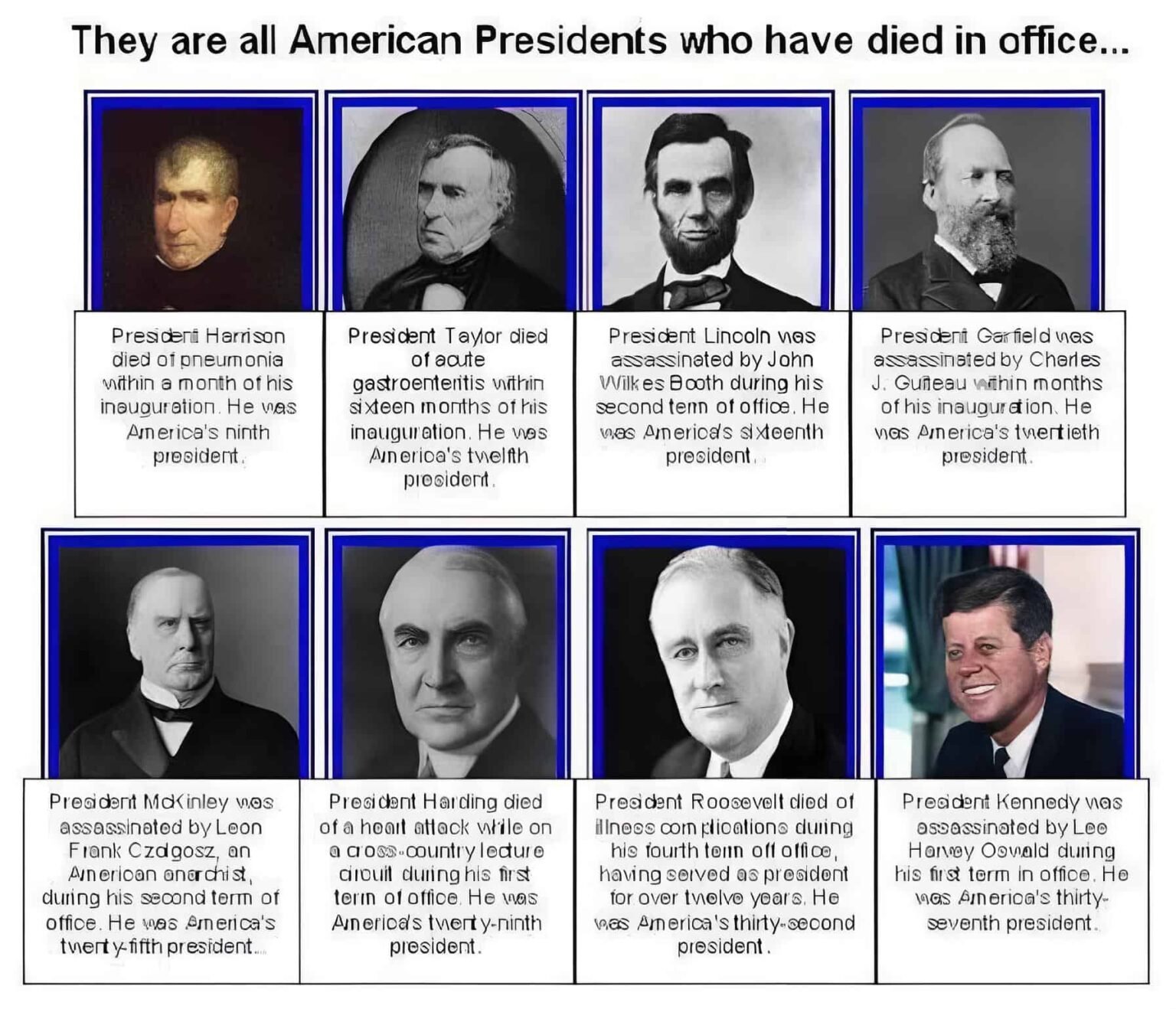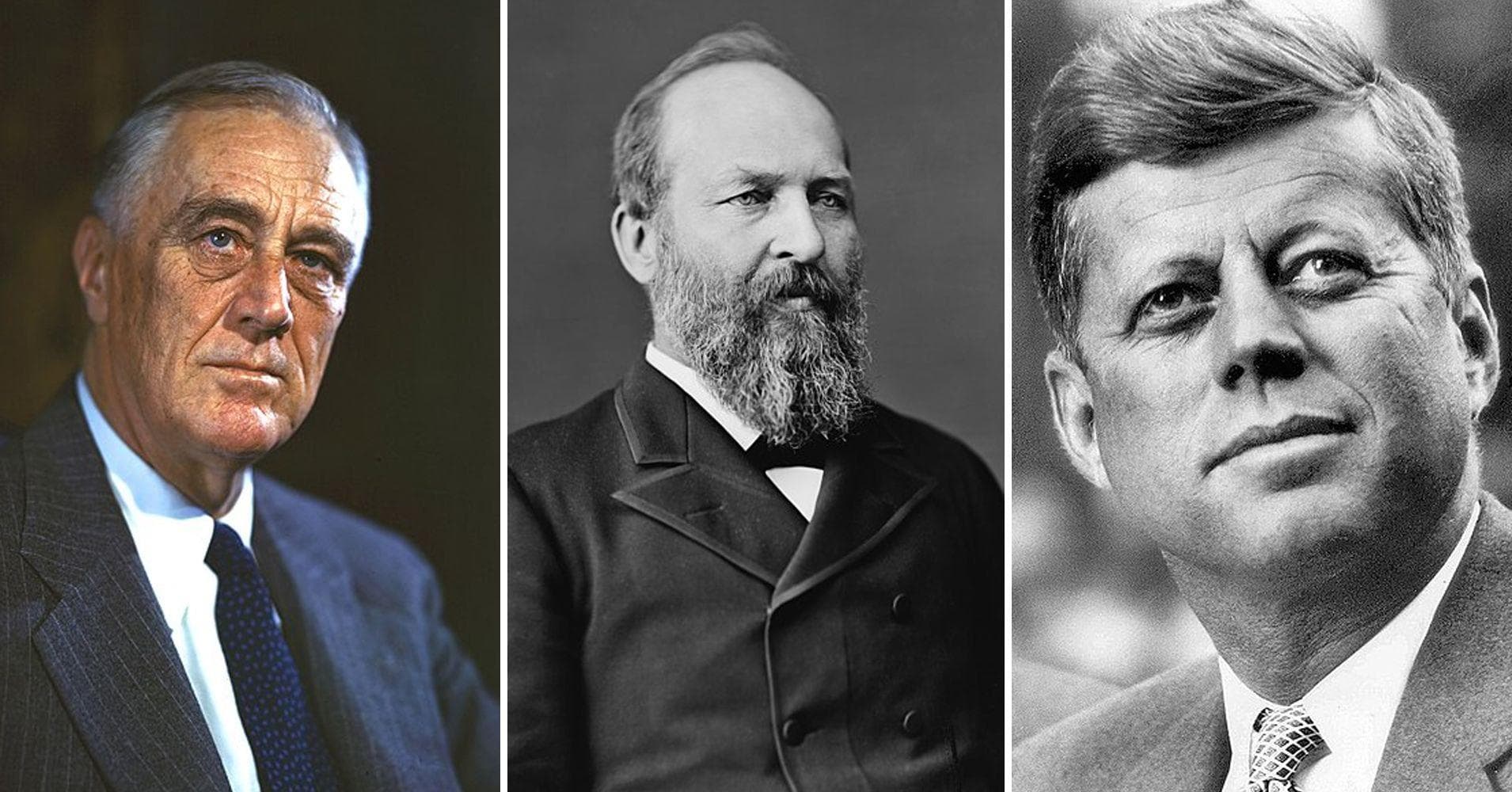8 US Presidents Who Died In Office: Facts & History | News
Have you ever considered the immense weight of the American presidency, and the ultimate price some have paid while shouldering that burden? Eight United States presidents have met their end while occupying the Oval Office, a stark reminder of the inherent risks and relentless demands of the nation's highest post.
The death of a U.S. President in office is a pivotal moment in American history, triggering a cascade of constitutional procedures, political shifts, and profound emotional responses. The circumstances surrounding these deaths, whether from illness, assassination, or the relentless pressures of the job, provide a poignant lens through which to examine the realities of presidential leadership. From the early days of the republic to the modern era, the stories of these men and the impact of their passing offer valuable insights into the evolution of the presidency, the vulnerabilities of power, and the enduring legacy of these fallen leaders.
Here's a look at the eight U.S. Presidents who died in office, their causes of death, and the lasting impacts of their untimely departures:
- Tim Pools Wife Alison Neubauers Role Life With Tim
- Eminem Rachel Chandler Unraveling Their Complex Relationship
| President | Term in Office | Cause of Death | Date of Death | Vice President who Succeeded | Key Events During Presidency | Notable Achievements | Website |
|---|---|---|---|---|---|---|---|
| William Henry Harrison | March 4, 1841 April 4, 1841 | Pneumonia | April 4, 1841 | John Tyler | Briefest presidency in U.S. history; died 31 days after taking office. | Hero of the Battle of Tippecanoe. | WhiteHouse.gov |
| Zachary Taylor | March 4, 1849 July 9, 1850 | Cholera or Gastroenteritis (Possible) | July 9, 1850 | Millard Fillmore | Presided over the debate of slavery and statehood. | General in the Mexican-American War. | WhiteHouse.gov |
| Abraham Lincoln | March 4, 1861 April 15, 1865 | Assassination (Shot) | April 15, 1865 | Andrew Johnson | Civil War, Emancipation Proclamation. | Preserved the Union, abolished slavery. | WhiteHouse.gov |
| James A. Garfield | March 4, 1881 September 19, 1881 | Assassination (Shot) | September 19, 1881 | Chester A. Arthur | Began reforms to end the spoils system; shot four months into his term. | Short but impactful presidency, focused on civil service reform. | WhiteHouse.gov |
| Chester A. Arthur | September 19, 1881 March 4, 1885 | Bright's disease | November 18, 1886 | (None) | Focused on civil service reform. | Passed the Pendleton Civil Service Reform Act. | WhiteHouse.gov |
| William McKinley | March 4, 1897 September 14, 1901 | Assassination (Shot) | September 14, 1901 | Theodore Roosevelt | Spanish-American War, annexation of Hawaii. | Expansion of U.S. influence, economic prosperity. | WhiteHouse.gov |
| Warren G. Harding | March 4, 1921 August 2, 1923 | Heart attack | August 2, 1923 | Calvin Coolidge | Teapot Dome scandal emerged after his death | Focused on "return to normalcy" after World War I. | WhiteHouse.gov |
| Franklin D. Roosevelt | March 4, 1933 April 12, 1945 | Cerebral Hemorrhage | April 12, 1945 | Harry S. Truman | The Great Depression, World War II. | New Deal programs, led the U.S. through WWII. | WhiteHouse.gov |
| John F. Kennedy | January 20, 1961 November 22, 1963 | Assassination (Shot) | November 22, 1963 | Lyndon B. Johnson | Cuban Missile Crisis, Vietnam War buildup. | Inspired the nation with his vision and eloquence | WhiteHouse.gov |
William Henry Harrison's untimely death, just a month into his presidency in 1841, marked the beginning of this somber chapter. Afflicted by pneumonia, he succumbed at the White House, making him the shortest-serving president in U.S. history. His death highlighted the potential for fragility even at the highest echelons of power. The sudden shift of power to Vice President John Tyler set a precedent for presidential succession that would be tested and refined throughout the years.
Zachary Taylor's death in 1850, after a brief term, further underscored the unpredictability of the presidency. His demise, possibly from cholera or gastroenteritis, occurred at a critical juncture in the nation's history, as debates over slavery and westward expansion threatened to tear the Union apart. The succession of Millard Fillmore further complicated the political landscape.
The assassination of Abraham Lincoln on April 15, 1865, stands as one of the most tragic events in American history. Lincoln's assassination came at the very moment of the Union's victory over the Confederacy, as the Civil War was drawing to a close. The death of Lincoln, a man who embodied the nation's hopes for reconciliation, plunged the country into mourning and uncertainty. Andrew Johnson, his successor, inherited the complex task of Reconstruction, facing immense challenges in uniting a divided nation.
- Darren Tills Girlfriend Unveiling His Love Life Relationships
- Malia Obama Dawit Eklund Relationship Bio Updates
The assassination of James A. Garfield in 1881 brought the nation to a standstill once more. The new president, who had a keen interest in civil service reform, was shot just four months into his term. Garfields struggle for survival, which spanned over two months, captivated the public, who hoped for a recovery. Unfortunately, the president could not survive the gunshot wounds and eventually passed on in September of 1881. The assassination of Garfield, however, sparked a public outcry that fueled the drive for civil service reform, ultimately leading to the passage of the Pendleton Civil Service Reform Act.
William McKinley's assassination in 1901, occurring in Buffalo, New York, marked another dark day for the country. McKinley, a leader during the Spanish-American War, was shot by an anarchist and died a few days later. This event led to the elevation of Theodore Roosevelt to the presidency, a man who would dramatically reshape the office and the nation's role on the global stage. Roosevelt, in his time in office, also oversaw the expansion of the U.S. influence.
The death of Warren G. Harding in 1923, from a heart attack, added another layer of complexity. Harding's presidency was marred by scandal, and his death allowed the Teapot Dome scandal to emerge. His successor, Calvin Coolidge, inherited the task of restoring public trust and guiding the nation through a period of economic and social change.
Franklin D. Roosevelts passing in April 1945, as World War II neared its conclusion, brought an end to an era. Roosevelt, who had guided the United States through the Great Depression and the war, died of a cerebral hemorrhage. His death was felt globally, as he was a symbol of hope and resilience. His vice president, Harry S. Truman, stepped into the presidency at a pivotal moment in history, facing the decision of whether to use the atomic bomb. He continued to lead the country through the end of the war and the post-war reconstruction.
The assassination of John F. Kennedy in 1963, with the nation still reeling from the Cold War, sent shockwaves across the globe. Kennedy's youthful dynamism and vision of a "New Frontier" had inspired millions. His assassination on November 22 in Dallas, Texas, was a watershed moment. The death of Kennedy, a leader whose death was one of the most tragic, impacted the country on a national level. Lyndon B. Johnson, his successor, took on the presidency at a time of intense national grief and political turmoil. Johnson's presidency, shaped by the Vietnam War and the Civil Rights Movement, would leave a lasting mark on the nation.
These eight presidents, through their lives and deaths, left indelible marks on American history. Their stories serve as a reminder of the human cost of leadership, the fragility of life, and the enduring legacy of those who have served the nation.
The circumstances surrounding these deaths offer insight into the evolution of the presidency, and the vulnerabilities of power. The passing of these leaders have also resulted in significant shifts in policy, political alliances, and the direction of the United States.
The constitutional implications of a president's death are significant. The 25th Amendment to the U.S. Constitution, ratified in 1967, provides clear guidelines for presidential succession and disability, ensuring the continuity of government in times of crisis. The deaths of these presidents have also underscored the importance of presidential health and security, leading to increased precautions and medical protocols.
Looking beyond the immediate causes of death, the impact of a president's passing can be seen in the policies and actions of their successors. These changes have shaped the future of the nation.
- Patrick Flueger Age Wife More On The Chicago Pd Star
- Dina Meyer Age Relationships Career What You Need To Know

100+ Unusual Facts About 46 U.S. Presidents By Years

The 8 US Presidents Who Died In Office And What Happened After

Helpful Guide all the presidents who died in office, and what killed